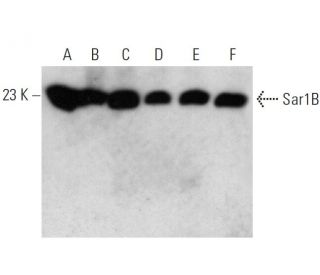


Sar1B Antibody (AT1C7): sc-517425
- Sar1B Antibody (AT1C7) is a mouse monoclonal IgG1 κ, cited in 2 publications, provided at 100 µg/ml
- raised against a recombinant protein corresponding to amino acids 1-198 of Sar1B of human origin
- recommended for detection of Sar1B of mouse, rat and human origin by WB, IP, IF, FCM and ELISA
- At present, we have not yet completed the identification of the preferred secondary detection reagent(s) for Sar1B Antibody (AT1C7). This work is in progress.
QUICK LINKS
Sar1B Antibody (AT1C7) is a mouse monoclonal IgG1 kappa light chain antibody that detects Sar1B protein of mouse, rat, and human origin by western blotting (WB), immunoprecipitation (IP), immunofluorescence (IF), flow cytometry (FCM), and enzyme-linked immunosorbent assay (ELISA). Anti-Sar1B antibody (AT1C7) is available as the non-conjugated form, providing versatility for various experimental needs. Sar1B protein plays a crucial role in the secretory pathway of cells, specifically in the formation of transport vesicles from the endoplasmic reticulum (ER). This process is vital for proper trafficking of secretory proteins to the Golgi complex, where proteins undergo further processing and sorting. Sar1B, along with its isoform Sar1a, belongs to a family of low-molecular-weight GTPases essential for budding of COPII-coated vesicles from the ER. Mutations in the SAR1 gene can lead to serious health issues, such as Anderson′s disease, a rare autosomal recessive disorder characterized by lipid malabsorption, chronic diarrhea, and failure to thrive in childhood. Sar1B′s ability to facilitate vesicular transport underscores its importance in maintaining cellular homeostasis and proper physiological function, making Sar1B (AT1C7) monoclonal antibody an invaluable tool for researchers studying cellular transport mechanisms and related disorders.
Alexa Fluor® is a trademark of Molecular Probes Inc., OR., USA
LI-COR® and Odyssey® are registered trademarks of LI-COR Biosciences
Sar1B Antibody (AT1C7) References:
- The intracellular transport of chylomicrons requires the small GTPase, Sar1b. | Shoulders, CC., et al. 2004. Curr Opin Lipidol. 15: 191-7. PMID: 15017362
- Sequence identification, tissue distribution, mapping and polymorphism of the porcine sar1b gene. | Wang, XM., et al. 2006. Anim Biotechnol. 17: 99-107. PMID: 16621763
- Anderson or chylomicron retention disease: molecular impact of five mutations in the SAR1B gene on the structure and the functionality of Sar1b protein. | Charcosset, M., et al. 2008. Mol Genet Metab. 93: 74-84. PMID: 17945526
- Anderson's disease (chylomicron retention disease): a new mutation in the SARA2 gene associated with muscular and cardiac abnormalities. | Silvain, M., et al. 2008. Clin Genet. 74: 546-52. PMID: 18786134
- Sar1 promotes vesicle budding from the endoplasmic reticulum but not Golgi compartments. | Kuge, O., et al. 1994. J Cell Biol. 125: 51-65. PMID: 8138575
- Transcriptional studies on yeast SEC genes provide no evidence for regulation at the transcriptional level. | Vahlensieck, Y., et al. 1995. Yeast. 11: 901-11. PMID: 8533466
- Sec31 encodes an essential component of the COPII coat required for transport vesicle budding from the endoplasmic reticulum. | Salama, NR., et al. 1997. Mol Biol Cell. 8: 205-17. PMID: 9190202
- Protein and lipid sorting between the endoplasmic reticulum and the Golgi complex. | Nickel, W., et al. 1998. Semin Cell Dev Biol. 9: 493-501. PMID: 9835636
- Identification of SEC12, SED4, truncated SEC16, and EKS1/HRD3 as multicopy suppressors of ts mutants of Sar1 GTPase. | Saito, Y., et al. 1999. J Biochem. 125: 130-7. PMID: 9880808
Ordering Information
| Product Name | Catalog # | UNIT | Price | Qty | FAVORITES | |
Sar1B Antibody (AT1C7) | sc-517425 | 100 µg/ml | $316.00 |
